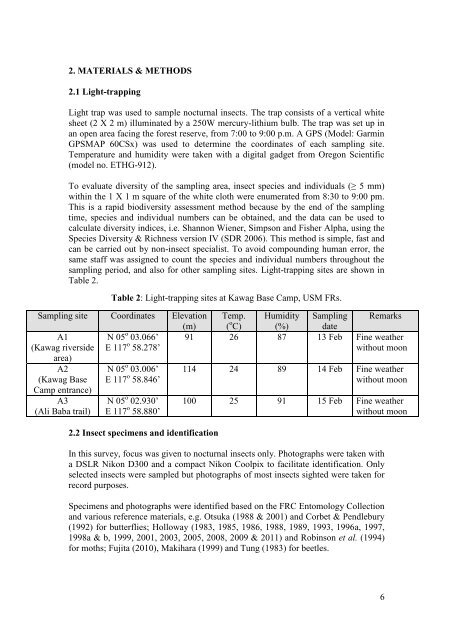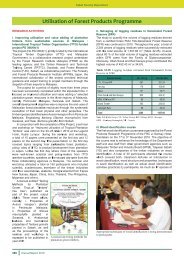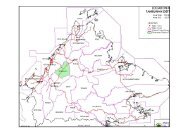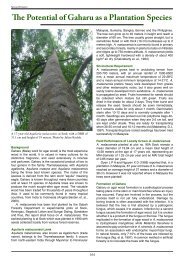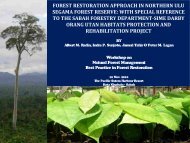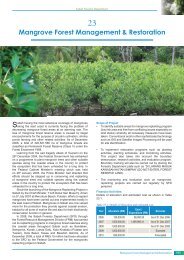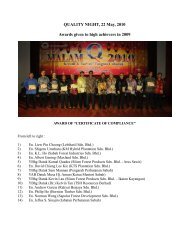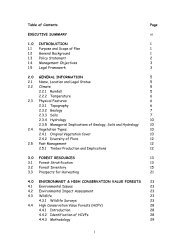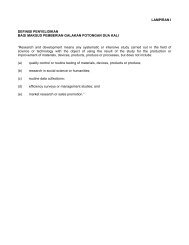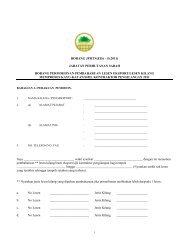Malaysia - Sabah Forestry Department
Malaysia - Sabah Forestry Department
Malaysia - Sabah Forestry Department
Create successful ePaper yourself
Turn your PDF publications into a flip-book with our unique Google optimized e-Paper software.
2. MATERIALS & METHODS2.1 Light-trappingLight trap was used to sample nocturnal insects. The trap consists of a vertical whitesheet (2 X 2 m) illuminated by a 250W mercury-lithium bulb. The trap was set up inan open area facing the forest reserve, from 7:00 to 9:00 p.m. A GPS (Model: GarminGPSMAP 60CSx) was used to determine the coordinates of each sampling site.Temperature and humidity were taken with a digital gadget from Oregon Scientific(model no. ETHG-912).To evaluate diversity of the sampling area, insect species and individuals (≥ 5 mm)within the 1 X 1 m square of the white cloth were enumerated from 8:30 to 9:00 pm.This is a rapid biodiversity assessment method because by the end of the samplingtime, species and individual numbers can be obtained, and the data can be used tocalculate diversity indices, i.e. Shannon Wiener, Simpson and Fisher Alpha, using theSpecies Diversity & Richness version IV (SDR 2006). This method is simple, fast andcan be carried out by non-insect specialist. To avoid compounding human error, thesame staff was assigned to count the species and individual numbers throughout thesampling period, and also for other sampling sites. Light-trapping sites are shown inTable 2.Table 2: Light-trapping sites at Kawag Base Camp, USM FRs.Sampling site Coordinates Elevation(m)A1 N 05 o 03.066’(Kawag riverside E 117 o 58.278’area)A2(Kawag BaseCamp entrance)A3(Ali Baba trail)N 05 o 03.006’E 117 o 58.846’N 05 o 02.930’E 117 o 58.880’2.2 Insect specimens and identificationTemp.( o C)Humidity(%)SamplingdateRemarks91 26 87 13 Feb Fine weatherwithout moon114 24 89 14 Feb Fine weatherwithout moon100 25 91 15 Feb Fine weatherwithout moonIn this survey, focus was given to nocturnal insects only. Photographs were taken witha DSLR Nikon D300 and a compact Nikon Coolpix to facilitate identification. Onlyselected insects were sampled but photographs of most insects sighted were taken forrecord purposes.Specimens and photographs were identified based on the FRC Entomology Collectionand various reference materials, e.g. Otsuka (1988 & 2001) and Corbet & Pendlebury(1992) for butterflies; Holloway (1983, 1985, 1986, 1988, 1989, 1993, 1996a, 1997,1998a & b, 1999, 2001, 2003, 2005, 2008, 2009 & 2011) and Robinson et al. (1994)for moths; Fujita (2010), Makihara (1999) and Tung (1983) for beetles.6


